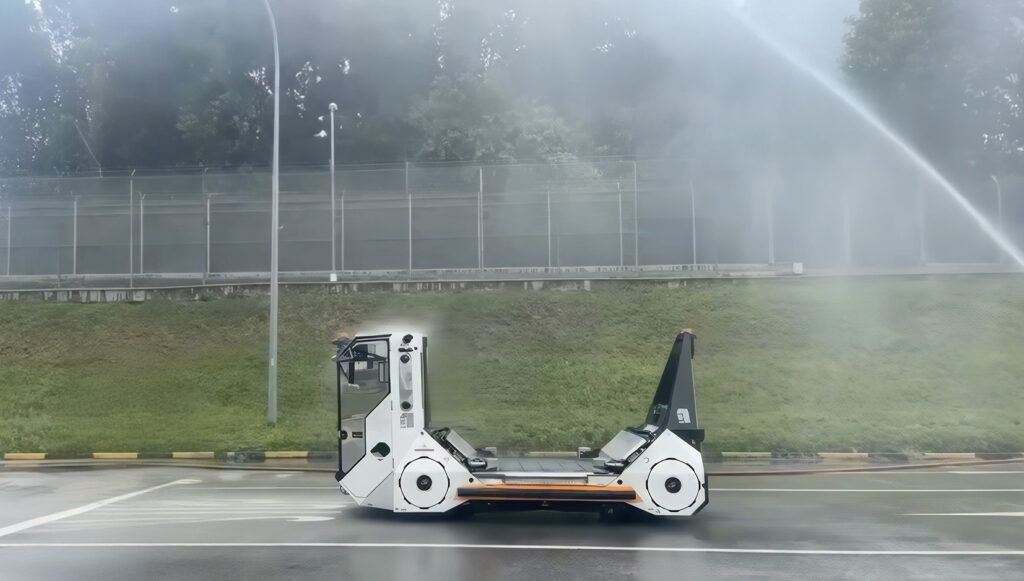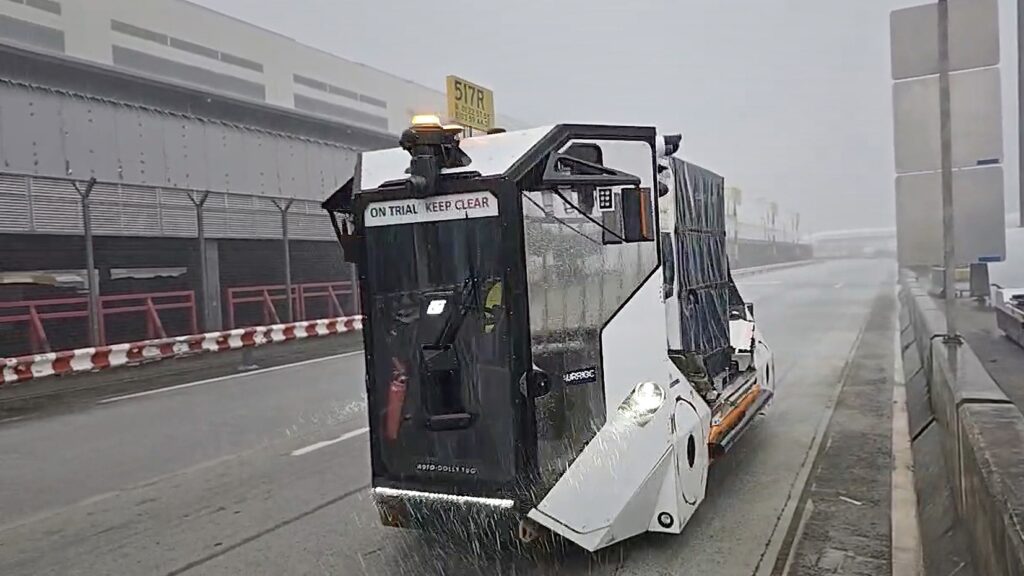
Aurrigo International plc has developed new software to help airports overcome the challenge of operating autonomous vehicles in intense wet weather and snow. Specialists in innovative airside solutions have developed a new rainfall algorithm that will help detect the difference between drops of rain and objects while operating at up to 50mm of precipitation per hour.
The housing provides better protection for LiDAR sensors. Thanks to software advancement, the Auto-DollyTug can move baggage and cargo in rough weather conditions that would have stopped manual handling. This capability was tested successfully during scheduled simulated rain and unexpected heavy rainfall. These tests were confirmed by observation and rain meter readings.
“Traditionally, very heavy rain has presented a significant problem for autonomous vehicles, particularly for LiDAR detection and navigation,” explained Simon Brewerton, chief technical officer at Aurrigo International plc. “AVs using this technology rely on the reflection feedback of laser beams for localisation and object recognition and, in intense weather, the scattering and absorption of laser beams by raindrops can lead to distorted signals, compromising the vehicle’s ability to accurately perceive its surroundings.”
He continued: “The first stage of the solution was to design the latest Auto-DollyTug with better casing protection for the LiDARs, which we duly did. However, the big ‘Eureka’ moment for us and the sector is the algorithm we have trained to strike a balance between the removal of raindrops and retaining the ability to detect real obstacles. “This means that airlines and airport operators have complete confidence that, even in extreme rain conditions, our autonomous dollies will operate efficiently.”
At the heart of the software are two features. Firstly, Aurrigo International’s technical team has ensured that the filtering of the rain is split into five spatial zones around the vehicle, with the strength of the filtering varying based on proximity. Secondly, due to differences in the scan properties between the unfiltered and filtered scans, low-lying obstacles and reflective surfaces were not detected, and this had to be built into the software, leading to the adjustment of field height settings and ‘near field’ low profiles being added.

Sam Layton, regional VP Singapore at Aurrigo International, noted: “The tests we did at a leading international airport had to prove the Auto-DollyTug could operate autonomously with no ghost or intermittent stops, react to a box and person injected into the vehicle’s path and safely navigate a T-junction airside with oncoming traffic left and right.
“All of this had to be achieved under 15mm of rainfall per the customer’s requirement, which we successfully passed. Since then, we have increased our capabilities and operated airside on live trials with rainfall of 50mm per hour. This is a real game-changing moment for autonomous vehicles and aviation.”
Manual operations must cease during a CAT5 lightning risk that occurs frequently in places like Singapore due to the rainforest climate and inclement weather. This is due to the electrocution risk to humans, but this is not a concern for autonomous vehicles, meaning there is potential to build an autonomous aircraft turnaround to enable autonomous operation even in extreme weather conditions. Sam added, “Automated equipment will be needed for baggage and cargo servicing, catering, water, and refueling. Our vehicles – Auto-DollyTug and Auto-Cargo -unlock the ULD and cargo pallet servicing pieces of that puzzle.
“Our enhancement, together with other advanced systems, mean flight schedules will be maintained whilst reducing risk of injury to airside workers, two key priorities for airlines, and airport and ground support operators.”
Aurrigo International, pioneering the iGSE (intelligent Ground Support Equipment) concept, has raised £5.25m to scale up its Auto-DollyTugs to meet global demand. The all-electric autonomous baggage and cargo vehicle transforms baggage and cargo handling operations at airports through enhanced safety, operational efficiency and reduced carbon emissions. The funding injection will provide the platform with 22 tugs in operation in 2025, accelerating commercial sales timelines and enabling the ‘go live’ moment with Auto-Cargo in partnership with UPS. Four live Auto-Sim contracts at international airports in the same period will help new and existing clients build digital twins of activity to optimize performance.
Source: Aurrigo
About Aurrigo International
Aurrigo International plc, headquartered in Coventry, UK, is a technology-driven company specializing in autonomous and automated solutions for the aviation and automotive industries. Established as part of the RDM Group, it has been in business for over 30 years, developing airside ground handling systems, baggage transportation and autonomous vehicle solutions. Aurrigo serves major airports, airlines, logistics providers, and automotive manufacturers, focusing on efficiency and sustainability through automation. Aurrigo has expanded globally, working with clients across North America, Europe, and Asia. As of recent financial reports, its annual revenue exceeds £10 million, with continuous growth driven by increased demand for innovative mobility solutions.
